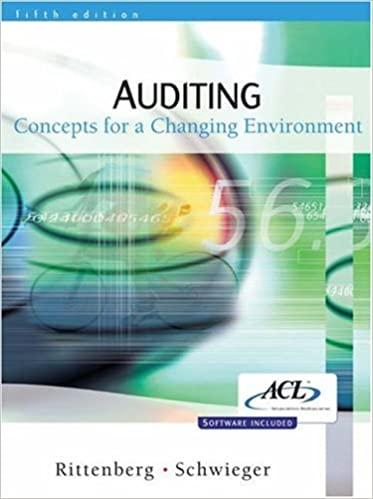Question
A firm has applies variable overhead with a standard rate of $10 per direct labor hour (assume there is no fixed overhead for this problem).
A firm has applies variable overhead with a standard rate of $10 per direct labor hour (assume there is no fixed overhead for this problem). The firm's static budget predicted 5,000 finished goods units (and the standard is for 0.5 direct labor hours to be used per finished good unit). This period's actual finished goods units were 6,000.
The firm's actual direct labor hours were 2,250, and the total actual variable overhead costs were $27,000.
What is the firm's variable overhead quantity variance (round final answer to nearest cent if necessary)?
| a. | $7,500 unfavorable | |
| b. | $3,000 unfavorable | |
| c. | $3,000 favorable | |
| d. | $7,500 favorable |
A firm's static budget predicted $125,000 in fixed overhead costs. The firm applied $135,000 of fixed overhead costs. The firm's actual fixed overhead costs were $117,000.
What is the firm's fixed overhead spending variance (round final answer to cents if necessary)?
| a. | $10,000 unfavorable | |
| b. | $10,000 favorable | |
| c. | $8,000 favorable | |
| d. | $8,000 unfavorable |
At the standard mix, the standard input price per finished goods unit is $3, and the standard number of input units per finished goods unit is 9. The firm's actually completed 10,004 finished goods units and used 116,951 input units.
What is the firm's yield variance?
NOTE: only input a number, without indicating favorability (for simplicity, I've made sure that the relevant variance equation leads to a positive number). Round final answer to cents if necessary.
A firm's static budget predicted $250,000 in fixed overhead costs. The firm's PDOH is $40 per machine hour, 75% of which was for variable overhead. The firm's actual machine hours were 24,000. The firm's actual fixed overhead costs were $265,000.
What is the firm's fixed overhead spending variance (round final answer to cents if necessary)?
| a. | $15,000 unfavorable | |
| b. | $15,000 favorable | |
| c. | Cannot be determined from this information because we lack information on actual price and standard quantity | |
| d. | Cannot be determined from this information because we lack information on actual quantity and standard price. |
A firm has applies variable overhead with a standard rate of $10 per direct labor hour (assume there is no fixed overhead for this problem). The firm's static budget predicted 5,000 finished goods units (and the standard is for 0.5 direct labor hours to be used per finished good unit). This period's actual finished goods units were 6,000.
The firm's actual direct labor hours were 2,250, and the total actual variable overhead costs were $27,000.
What is the firm's variable overhead price variance (round final answer to nearest cent if necessary)?
| a. | $3,000 favorable | |
| b. | $4,500 favorable | |
| c. | $3,000 unfavorable | |
| d. | $4,500 unfavorable |
A firm has applies variable overhead with a standard rate of $20 per machine hour (assume there is no fixed overhead for this problem). The firm's actual finished goods units were 10,000. The standard quantity is 2 machine hours per finished good unit.
The firm's actual machine hours were 21,000, with an actual cost per machine hour of $22.
What is the firm's variable overhead quantity variance (round final answer to nearest cent if necessary)?
| a. | $22,000 favorable | |
| b. | $22,000 unfavorable | |
| c. | $20,000 unfavorable | |
| d. | $20,000 favorable |
Step by Step Solution
There are 3 Steps involved in it
Step: 1

Get Instant Access to Expert-Tailored Solutions
See step-by-step solutions with expert insights and AI powered tools for academic success
Step: 2

Step: 3

Ace Your Homework with AI
Get the answers you need in no time with our AI-driven, step-by-step assistance
Get Started


